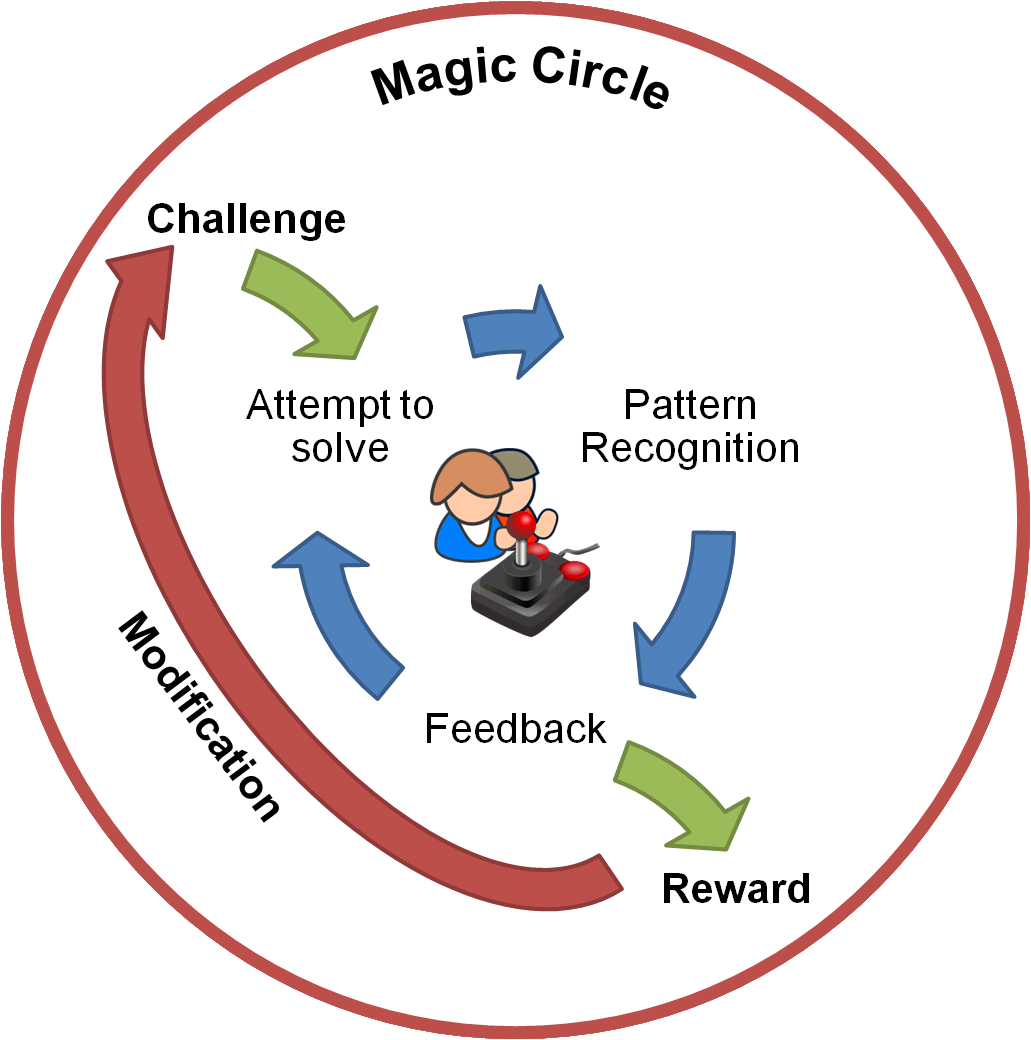As I read more and more about what makes a game a game, it becomes more and more clear where things with gamification can and do go wrong. I am not trying to say that gamification and games are the same thing, they are not, but they do share similar qualities.
At their core, games share many common traits
- Challenge
- Learning
- Pattern Recognition
- Feedback
- A safe environment to fail
- Sense of reward
The Challenge, Feedback, Reward Cycle
The diagram below tries to capture this in a cycle (because I like pictures). For the sake of continuity, I am referring to the “Safe environment to fail” as the Magic Circle.
This is a gross over simplification of games and the systems that make them “fun”, but it will do for our purposes to illustrate some of the issues we may face in gamification!
Most gamification does have some pattern recognition. If I do this, something happens. It may be clicking a like button and getting a point, it may be completing certain challenges in some elaborate fantasy based learning system. What is missing from most gamification is that the challenge needs to actually change over time. If you keep playing the same game over and over and the challenge never changes – it becomes boring very fast. Raph Koster uses Tic Tac Toe (Noughts and Crosses) as an example of this. When you don’t recognise the patterns, there is a challenge to the game. As soon as you learn the optimal strategies and play an opponent of similar skill – the game no longer represents a challenge, there is nothing left to discover and it becomes unsatisfying and no longer fun. There is not much challenge in clicking a like button…
I have covered rewards and their use quite a lot recently, so won’t bother here except to say that rewards must be meaningful. In games the reward is not just a point, it is often learning a new skill to make new things possible or unlocking something for a character or just access to the next part of the game. In gamification the reward could be similar – thing beyond points and badges and look at more intrinsic rewards! (RAMP).
Similar for feedback. I have covered it before, but it can be anything from simple prompts to actual rewards themselves. Again, they have to be meaningful and in context to what the user is doing.
A safe place to fail
For me the biggest issue with how the Challenge, Feedback, Reward cycle in gamification is not the cycle so much as what it is contained in – the Magic Circle.
In an enterprise setting, when was the last time you were told “It’s okay if you fail as long as you learn from it”? In a game, failure is part of the learning process. You keep failing and retrying until you recognise the pattern and discover the solution, How many times must Sonic hit the spikes before you discover the optimum moment to jump? How many goes at Tetris does it take to get the end screen? This all requires this safe environment to fail. The must feel secure that failing will not be punished so harshly that they lose all interest in the game. That is not to say that punishment can’t be harsh. Losing all your kit is as you die in an RPG is annoying as hell, but not the end of the game for you! It does however make you a touch more careful the next time you approach the same situation – or a touch more prepared.
At work, if you fail it is usually followed by some form of punishment. Unlike the game world, this also tends to have a direct impact on your real life. If a gamified system is in use at work, users may well feel that not only is it still not safe to fail, but it may be even easier to track than ever that they have failed. That safe environment just does not naturally exist.
3 Gamification tips from games
- Challenge has to change otherwise it is no longer a challenge
- Reward has to be meaningful (avoiding “What’s in it for me” issues)
- The gamified system has to offer a safe environment to fail
A final bonus tip. Get Raph Kosters A Theory of Fun for Game Design 10th Anniversary edition and read it cover to cover. It will open your eyes and your mind and make you a better designer!

Thanks for sharing this – great article!